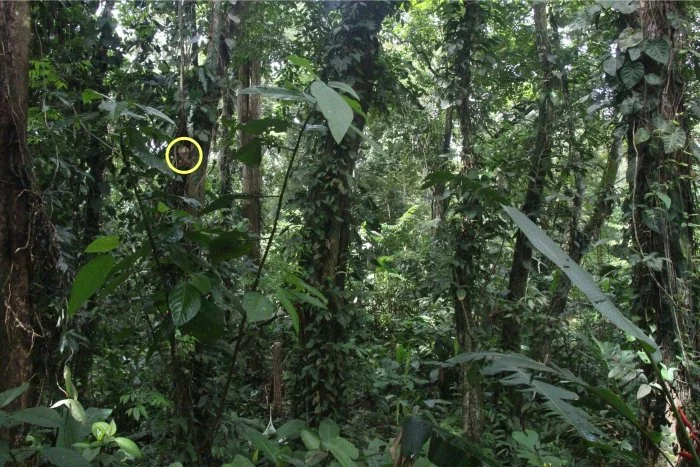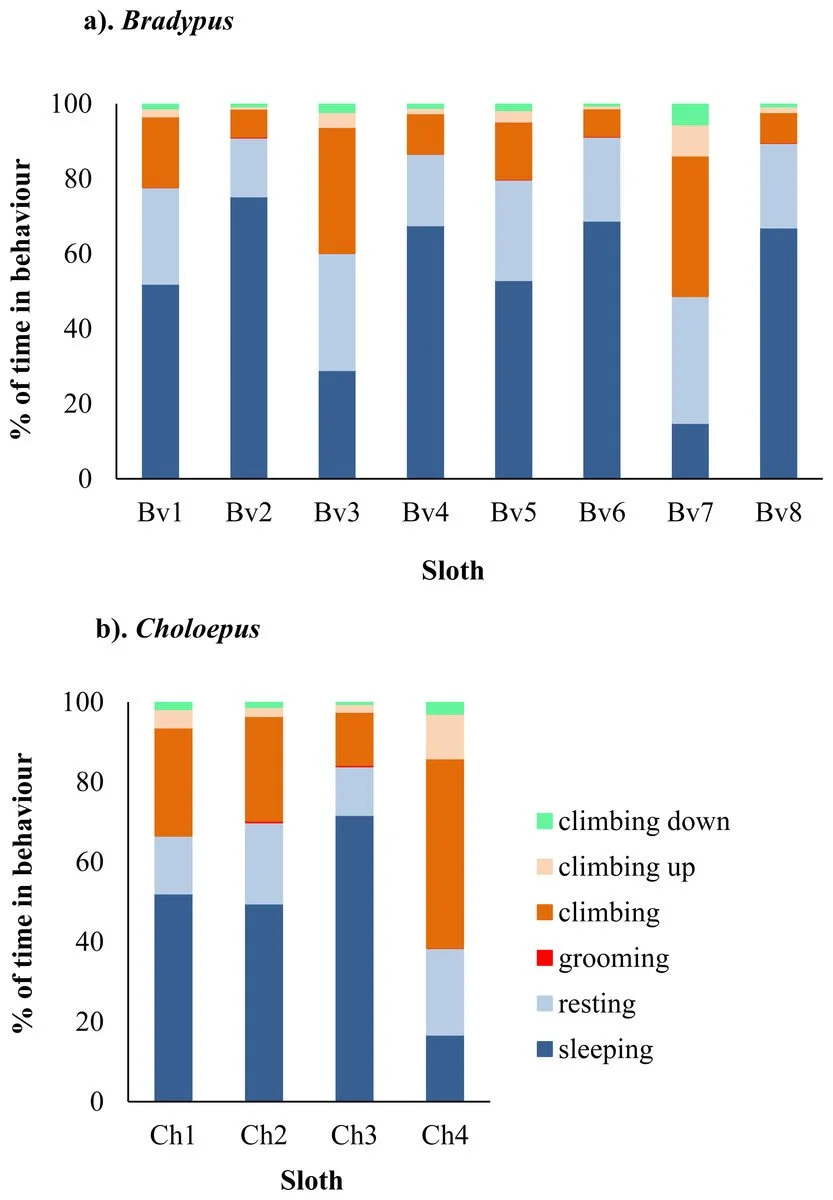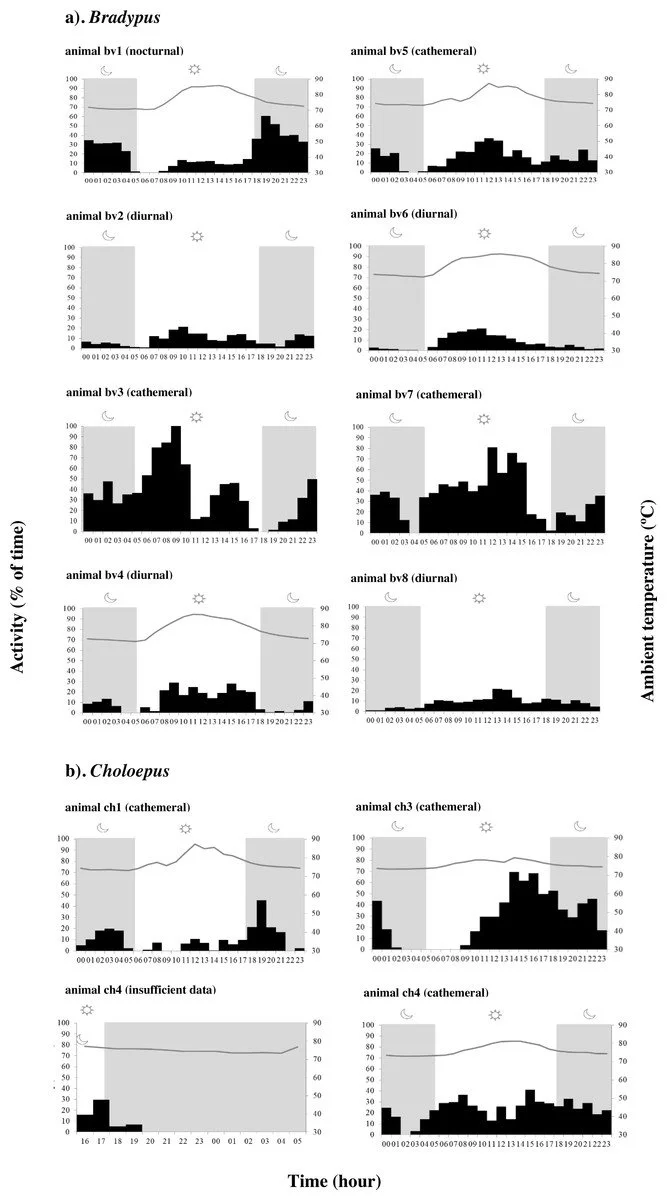2023 | Unveiling the Behavior and Activity of Sloths
In this newly published research called The behaviour and activity budgets of two sympatric sloths; Bradypus variegatus and Choloepus hoffmanni, led by Dr. Rebecca Cliffe, we conduct one of the most in-depth studies to date investigating the behavior and activity of the two sloth species found in Costa Rica.
Sympatry is the term used to describe populations, varieties, or species that occur in the same place at the same time. Choloepus hoffmanni (left) and Bradypus variegatus (right). Photos: Suzi Eszterhas
Activity Patterns and Activity Budgets
The activity patterns of animals play a crucial role in their survival and reproductive success. For most animals, the 24-hour day is divided between periods of activity and rest. The way these patterns are distributed throughout the day and/or night differ between species, although most animals can be categorized as either being diurnal (active during the day), nocturnal (active at night), or crepuscular(active at dusk and dawn). Animals are occasionally cathemeral, which is a combination of all three.
Animals also differ in the amount of time that they allocate to different behaviors (this is called an animal's activity budget), and understanding this, as well as their ability to adapt to environmental change, is important for developing effective conservation efforts - especially in the face of climate change.
The Cryptic Nature of Sloths
Sloths, with their slow movements and exceptional camouflage, have been difficult creatures to study in the wild. Consequently, there is very little literature documenting the activity patterns of these cryptic canopy-dwelling mammals.
A sloth in a secondary forest.
Three-fingered sloths (Bradypusvariegatus) are thought to be cathemeral, while Choloepus (two-fingered) sloths are considered to be nocturnal. At cooler ambient temperatures, often in high-altitude areas, previous research has suggested that sloths are more active during the day, whereas sloths living in warmer lowland areas are thought to be more active at night.
However, a lot of this research has been hindered by the difficulty of collecting data on sloth behavior, and consequently, sample sizes are small and nighttime data is almost lacking entirely. Making direct observations on sloths during the daytime is difficult - at night, this becomes almost impossible.
Sloth Activity: Who and Where
We used the latest modern animal tracking technology during this study to overcome this problem. We used micro data loggers to continuously monitor the activity of eight three-fingered sloths (Bradypus variegatus) and seven two-fingered sloths (Choloepus hoffmanni) sloths over multiple days and weeks in a protected area of secondary forest.
We also simultaneously monitored the environmental conditions, measuring everything from temperature and rainfall to wind speed and humidity.
This is Bojangles, one of our most famous sloths, who was part of the study, wearing a sloth backpack with a data logger
Sloth Activity and Budgets: The Findings
A total of 2356 hours of continuous behavioral data was collected for Bradypus sloths and 206 hours for Choloepus sloths (the first continuous record of Choloepus sloth behavior ever recorded in the wild).
We found that:
Three-fingered sloths (Bradypus) were inactive for 85.5% of the time - 62.7% of the time was spent sleeping, and 22.8% of the time was spent resting
Two-fingered sloths (Choloepus) were inactive for 72.6% of the study time - 56.4% was of time spent sleeping, and 16.2% of the time was spent resting
Figure 1: Variation in the percent of time spent in different behaviors for eight wild Bradypus (A) and four wild Choloepus (B) sloths. Each behavior is denoted by a different color.
These overall low levels of activity are what we would expect to see from a folivorous (leaf-eating) mammal with a low metabolic rate.
What we didn’t expect to see, however, is how much individual sloths varied their activity levels on different days. There was a surprising lack of synchronicity within the same population (there was a lot of variability in activity levels between different sloths and between the same sloths on consecutive days).
Each individual in our study had a unique activity pattern - possibly indicating a lack of a circadian rhythm entirely. This asynchrony among sloths within a single population may serve as an effective predator avoidance strategy, enhancing their survival by increasing unpredictability.
Figure 2: Variation in the periodicity of activity and ambient temperature over 24 h for (A) Bradypus sloths and (B) four Choloepus sloths in Costa Rica to illustrate inter-individual variation. Dark phases are shown by grey shading.
Sloth Activity: The Influencers
Contrary to our expectations, the environmental conditions did not seem to affect sloth activity very much at all. However, we were surprised to discover that three-fingered sloths showed increased nocturnal activity on colder nights and nights following colder days.
All sloths were typically active in frequent small bursts lasting on average 5 - 9 minutes, interspersed by longer resting/sleeping periods.
Sloths were found to spend more time moving vertically (climbing up and down the trees) during the night than during the day. This suggests that they may prefer to come down to the ground at night, which is surprising since there is a greater risk of being preyed upon by large cats that are active at night. Another possibility is that sloths simply move more slowly at night.
While two-fingered sloths were previously considered to be strictly nocturnal, we found that they were actually cathemeral (active during both the daytime and the nighttime). Our sample size was small, though, so this is something that we are exploring further with our ongoing research.
Conservation Implications:
Given the threats sloths face due to climate change and habitat loss, understanding the effect of environmental change on sloth behavior is increasingly important for the conservation of the species. This research provides us with valuable insights into how sloths live and how we can best act to protect them.
-Cecilia Pamich
Communications & Outreach
-Amelia Symeou
Ecology Coordinator








